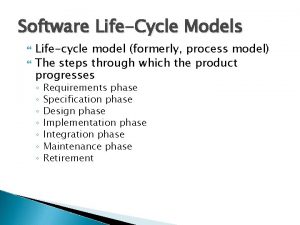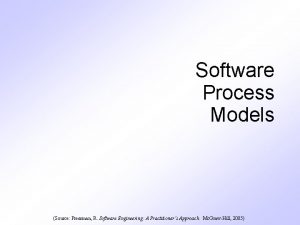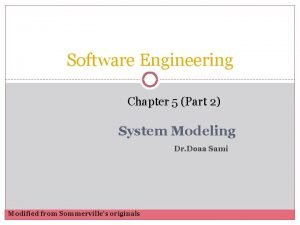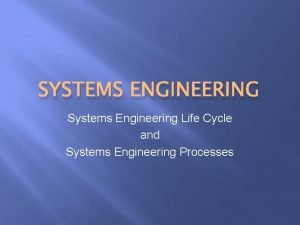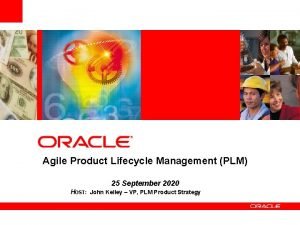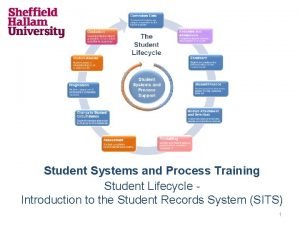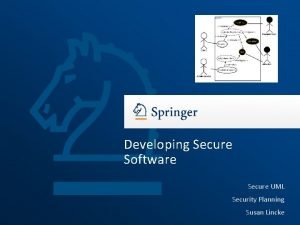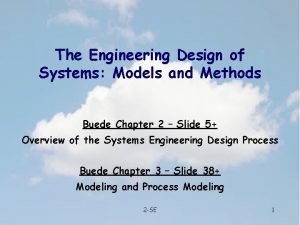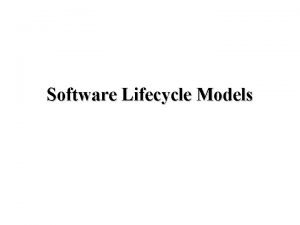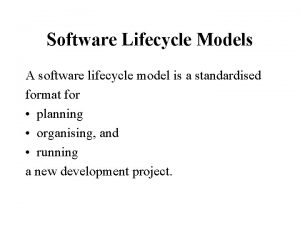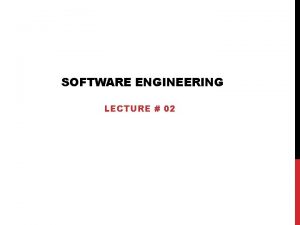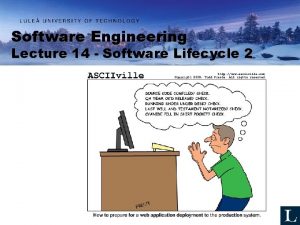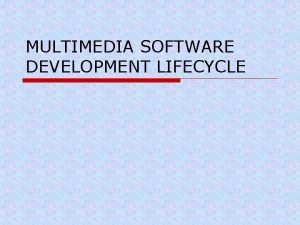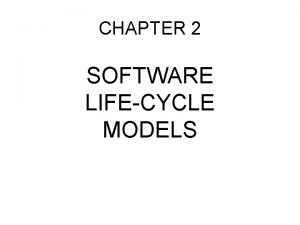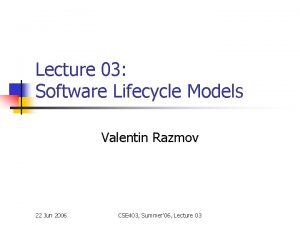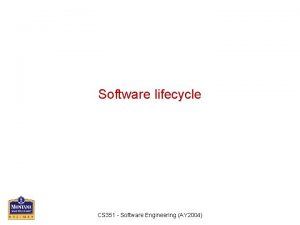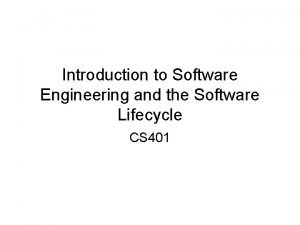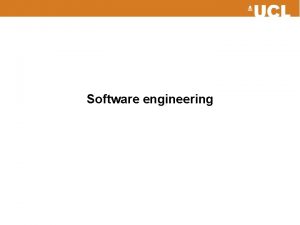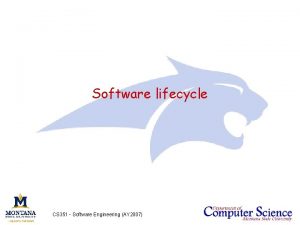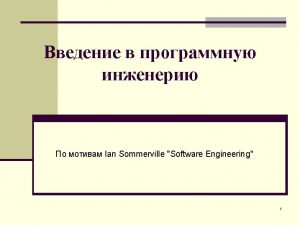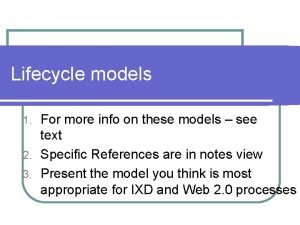Software Engineering Lecture 17 Software Lifecycle Models The























- Slides: 23

Software Engineering Lecture 17

Software Lifecycle Models The way you organize your activities Lifecycle model is a series of steps through which the product progresses

Software Life-Cycle Steps Life-cycle model (formerly, process model) › › › › Requirements phase Specification phase Design phase Implementation phase Integration phase Maintenance phase Retirement

Build and Fix Model Build first version Modify until client is satisfied Maintenance phase Development Maintenance Retirement

Build and Fix Model 1. It is unfortunate that many products are developed using what is known as the build-and-fix model. 2. The product is constructed without specification or any attempt at design. 3. The developers simply build a product that is reworked as many times as necessary to satisfy the client. 4. May work for small projects but is totally unsatisfactory for products of any reasonable size. 5. The cost of build-and fix is actually far greater than the cost of properly specified and carefully designed product. 6. Maintenance of the product can be extremely in the absence of any documentation.

Waterfall Model Requirement Definition System and Software Design Implementation and Unit Testing Integration and System Testing Operation and Maintenance

Waterfall Model The first published model of the software development process was derived from other engineering processes. Because of the cascade from one phase to another, this model is known as the waterfall model. This model is also known as linear sequential model.

Waterfall Model The five stages above are as follows: 1. Requirement Analysis and Definition: What - The systems services, constraints and goals are established by consultation with system users. They are then defined in detail and serve as a system specification. 2. System and Software Design: How – The system design process partitions the requirements to either hardware of software systems. It establishes and overall system architecture. Software design involves fundamental system abstractions and their relationships.

Waterfall Model 3. Implementation and Unit Testing: - How – During this stage the software design is realized as a set of programs or program units. Unit testing involves verifying that each unit meets its specifications. 4. Integration and system testing: The individual program unit or programs are integrated and tested as a complete system to ensure that the software requirements have been met. After testing, the software system is delivered to the customer.

Waterfall Model 5. Operation and Maintenance: Normally this is the longest phase of the software life cycle. The system is installed and put into practical use. Maintenance involves correcting errors which were not discovered in earlier stages of the life-cycle, improving the implementation of system units and enhancing the system’s services as new requirements are discovered.

Waterfall Model Requirement Definition System and Software Design Implementation and Unit Testing Integration and System Testing Operation and Maintenance

Waterfall Model(variation) Real projects rarely follow the sequential flow that the model proposes. In general these phases overlap and feed information to each other. Hence there should be an element of iteration and feedback. A mistake caught any stage should be referred back to the source and all the subsequent stages need to be revisited and corresponding documents should be updated accordingly. Because of the costs of producing and approving documents, iterations are costly and require significant rework.

Rapid Prototyping Model Rapid Prototyping Requirement Definition System and Software Design Implementation and Unit Testing Integration and System Testing Operation and Maintenance

Incremental Model the product is partitioned into smaller pieces which are then built and delivered to the client in increments at regular intervals. Since each piece is much smaller than the whole, it can be built and sent to the client quickly. This results in quick feedback from the client and any requirement related errors or changes can be incorporated at a much lesser cost.

Incremental Model Requirements phase Verify Specification phase Verify Architectural design Verify For each build: Perform detailed design, implementation and integration, test, deliver to client Maintenance phase Development Maintenance Retirement

Incremental Model (cont. ) Build 1 Specification Implementation, integration Design Deliver to client Build 2 Specification Implementation, integration Design Deliver to client Build 3 Specification Implementation, integration Design Deliver to client Build n Specification team Design Implementation, integration team Deliver to client

Synchronize and Stabilize Model The requirements analysis interviews of potential customers are conducted and requirements document is developed. Once these requirements have been captured, specifications are drawn up. The project is then divided into 3 or 4 builds. Each build is carried out by small teams working in parallel. At the end of each day the code is synchronized (test and debug) and at the end of the build it is stabilized by freezing the build and removing any remaining defects. Because of the synchronizations, components always work together. The presence of an executable provides early insights into operation of product.

Rapid Application Development (RAD) Rapid application development is another form of incremental model. It is a high speed adaptation of the linear sequential model in which fully functional system in a very short time (2 -3 months). This model is only applicable in the projects where requirements are well understood and project scope is constrained. Because of this reason it is used primarily for information systems.


Spiral Model Precede each phase by › Alternatives › Risk analysis Follow each phase by › Evaluation › Planning of next phase

Simplified Spiral Model Risk Analysis If risks cannot be resolved, project is immediately terminated Verify Rapid Prototype Specification Design Implementation Integration

Full Spiral Model Angular dimension (progress) Radial dimension (cost)

Maintenance Further development Fountain Model Operations Implementation and integration Implementation Object-oriented design Object-oriented analysis Requirements • Features – Overlap (parallelism) – Arrows (iteration) – Smaller maintenance circle
 Object oriented life cycle model
Object oriented life cycle model Software engineering lecture notes
Software engineering lecture notes 01:640:244 lecture notes - lecture 15: plat, idah, farad
01:640:244 lecture notes - lecture 15: plat, idah, farad Process models in software engineering
Process models in software engineering What is domain model in software engineering
What is domain model in software engineering Ock
Ock Systems engineering life cycle phases
Systems engineering life cycle phases Semi modals examples
Semi modals examples Computer based system engineering
Computer based system engineering Forward engineering in software engineering
Forward engineering in software engineering Financial engineering notes
Financial engineering notes Foundation engineering lecture notes
Foundation engineering lecture notes Professional ethics in engineering notes
Professional ethics in engineering notes Student lifecycle software
Student lifecycle software Agile bom management
Agile bom management Student lifecycle software
Student lifecycle software Secureuml
Secureuml Software testing lifecycle
Software testing lifecycle The engineering design of systems: models and methods
The engineering design of systems: models and methods Software maintenance process models ppt
Software maintenance process models ppt What is software implementation in software engineering
What is software implementation in software engineering Metrics computer science
Metrics computer science Example of software crisis
Example of software crisis What is software measurement
What is software measurement
